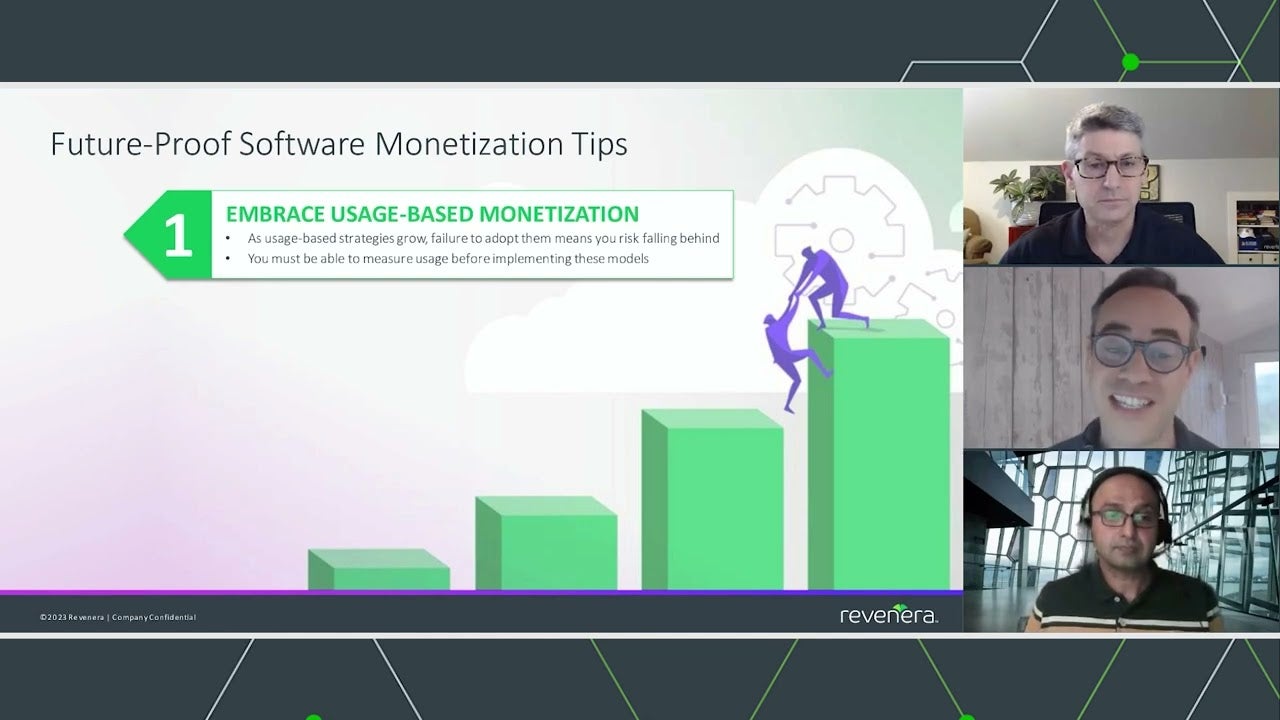Webinar
Future-Proofing Your Software Monetization Strategy
Explore usage-based pricing, hybrid models, and centralized licensing to boost recurring revenue and reduce churn.
Original Air Date: November 1, 2023
Overview
If you're a software producer navigating the complexities of modern monetization, this webinar is a must-watch. Hosted by Chris Cahill from the product marketing team at Revenera, and joined by Ravi Trivedi, Senior Product Manager for FlexNet Licensing, and Michael Goff, Principal of Product Marketing for Software Monetization, this session dives deep into the latest trends shaping the future of software revenue models. Drawing from the Monetization Monitor report, which surveyed 454 senior leaders at global tech companies, the webinar reveals how usage-based pricing, hybrid deployment models, and centralized entitlement management are transforming the industry.
You’ll learn why subscription and consumption-based models are surging, how perpetual licensing is evolving, and what it takes to build predictable recurring revenue. The speakers unpack the biggest barriers to growth—like delayed time to market and customer churn—and show how leading companies are overcoming them.
Whether you're scaling operations, exploring new pricing strategies, or looking to future-proof your monetization infrastructure, this webinar delivers actionable insights backed by real-world data. Don’t miss the opportunity to benchmark your strategy and stay ahead of the competition.
Recap
Key Themes and Takeaways
Embracing Usage-Based Monetization
One of the most significant shifts discussed in the webinar is the rise of usage-based pricing models. With consumption, metered, and outcome-based models all expected to grow by around 20% in the next 18 months, software producers are urged to adopt these flexible approaches to avoid falling behind. The speakers emphasized how these models support predictable recurring revenue, align with customer expectations to pay for what they use, and reduce friction in both selling and buying.
Centralizing Hybrid Monetization Strategies
As deployment models diversify, the need for a unified monetization platform becomes critical. The webinar highlighted that 47% of companies now use centralized technology across product lines, up from 32% the previous year. This centralization improves visibility into customer usage, aligns pricing with value, and supports seamless transitions between on-premises and SaaS offerings. It also enables producers to manage complexity at scale and streamline entitlement management across hybrid environments.
The Unexpected Rise of Perpetual Licensing
Despite the dominance of subscription and SaaS models, the webinar revealed a surprising 177% year-over-year increase in the expected use of perpetual licenses. This trend is driven by mature software segments and long-standing contractual ecosystems, particularly in regulated or high-cost environments. The speakers explained how producers are creatively sustaining recurring revenue through maintenance contracts while meeting customer demands for stability and control.
Deployment Model Trends: Cloud Smart vs. Cloud First
While SaaS continues to grow, on-premises software is also seeing a resurgence, with a 21% increase in expected use. This shift reflects a more nuanced "cloud smart" approach, where producers offer deployment flexibility based on customer needs. The webinar explored how hybrid deployment models are essential for supporting embedded software, regulated environments, and seasonal usage patterns, all while maintaining centralized control.
Overcoming Barriers to Revenue Growth
The webinar tackled common challenges such as delayed time to market, customer churn, and the inability to adopt new monetization models. By leveraging centralized platforms and usage data, producers can accelerate licensing changes, identify upsell opportunities, and improve retention. The speakers shared data showing that companies using Revanera’s platform saw up to a 15% revenue uplift and significant improvements in renewal rates and channel performance.
Leveraging Data-Driven Insights for Monetization
To support recurring revenue and customer success, the webinar introduced key metrics like renewals reports, high watermark usage tracking, and fulfillment reports. These insights help producers proactively manage entitlements, identify underutilization, and capture upsell opportunities. The emphasis on data-driven decision-making reinforces the importance of visibility and agility in modern software monetization strategies.
Speakers

Chris Cahill
Senior Product Marketing Manager
Revenera

Ravi Trivedi
Product Management, Software and Device Monetization
Revenera

Michael Goff
Principal Product Marketer
Revenera
Frequently Asked Questions
Usage-based monetization allows customers to pay based on actual consumption, such as metered usage or outcome-based value. It’s gaining traction because it aligns with customer expectations for flexibility and transparency. Software producers benefit from predictable recurring revenue and improved forecasting. This model also reduces friction in sales and purchasing processes, making it easier to attract and retain customers.
Transitioning from perpetual to subscription models involves rethinking packaging, pricing, and entitlement management. While perpetual licenses remain relevant in certain markets, subscription models offer more agility and recurring revenue potential. Companies should assess customer readiness, usage patterns, and internal systems to support the shift. A centralized monetization platform can ease the transition and ensure compliance across product lines.
Hybrid monetization combines multiple models—such as subscription, usage-based, and perpetual licensing—to meet diverse customer needs. This approach supports flexibility in deployment (cloud and on-premises) and monetization, enabling producers to scale across markets. It also helps manage complexity by aligning pricing with value and improving visibility into customer behavior. Hybrid strategies are especially useful during product transitions or acquisitions.
Centralized entitlement management provides a single view of customer access across all products and licensing models. It streamlines operations, improves compliance, and enables faster time to market for new features. Producers using centralized systems report better usage tracking, pricing alignment, and renewal performance. This infrastructure is critical for scaling monetization strategies and supporting hybrid deployments.
Reducing churn starts with aligning monetization models to customer expectations. Usage-based pricing, flexible licensing, and transparent value delivery help retain customers. Monitoring engagement through fulfillment and usage reports allows producers to identify risks early. Proactive renewal strategies and upsell opportunities based on real usage data can boost retention and lifetime value.
Key metrics include renewal rates, high watermark usage, and entitlement fulfillment. Renewal reports help assess customer health and readiness for contract extensions. High watermark data reveals peak usage patterns that can inform upsell strategies. Fulfillment reports show whether customers are using what they’ve purchased, highlighting engagement gaps or upsell potential. These insights drive smarter monetization decisions.
Yes, on-premises software remains relevant, especially in regulated industries or environments with limited connectivity. While SaaS adoption is growing, many producers are embracing a “cloud-smart” approach that includes hybrid deployments. Offering both cloud and on-prem options ensures broader market coverage and supports customer preferences. Hybrid deployment also enables smoother transitions and better data control.
Homegrown systems may offer tailored solutions but often come with high technical debt and scalability issues. They require ongoing engineering resources, which can divert focus from product innovation. These systems may lack integration with CRM and billing platforms, creating operational inefficiencies. Commercial entitlement management platforms offer faster deployment, better support, and future-proofing capabilities.
Usage-based pricing lowers entry barriers for customers by allowing them to pay only for what they use. This model supports dynamic pricing, enabling producers to adjust packages based on customer value. It also reduces procurement friction and accelerates decision-making. Sales teams benefit from clearer value propositions and more opportunities for upsell and cross-sell.
Common barriers include delayed time to market, customer acquisition challenges, and difficulty adopting new monetization models. Inefficient quote-to-cash processes and lack of visibility into customer entitlements also hinder growth. Addressing these issues requires centralized systems, flexible licensing, and data-driven insights. Software producers that embrace modern monetization strategies can overcome these hurdles and unlock new revenue streams.
Resources
Webinar
AI Monetization Unlocked: Master Pricing Models and Plan for Market Success
Tuesday, January 27, 2026
Join IDC's Tiffany McCormick, Research Director, AI Monetization, Pricing Strategies, and Business Models and Revenera's Paul Bland, VP, Product Management to learn pragmatic ways to align price with value—and avoid the cost‑plus trap.
Webinar
Revenera Connect 2026: Boston
Wednesday, February 11
Webinar
6 Steps to Launching Usage-Based Pricing for SaaS and AI
Tuesday, February 17, 2026
In this webinar, Nicole Segerer, General Manager at Revenera, will share this practical 6-step framework for launching usage-based pricing in SaaS, AI, and even on-premises products.
Want to learn more?
See how Revenera's Software Monetization platform can help you take products to market fast, unlock the value of your IP and accelerate revenue growth.
